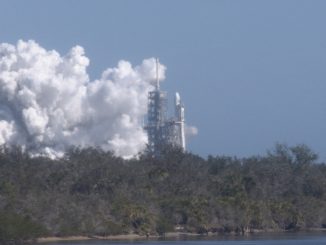EDITOR’S NOTE: Updated after SpaceX scrubbed Wednesday’s launch attempt.
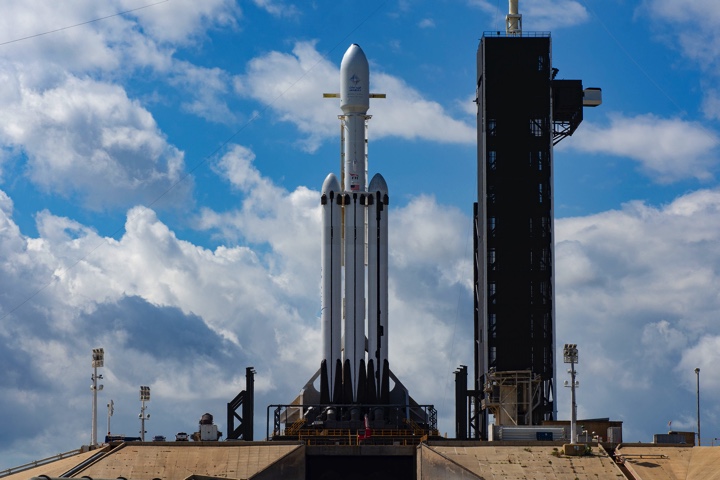
A little more than a year after the Falcon Heavy rocket’s first test flight, SpaceX teams on Florida’s Space Coast are readying the world’s most powerful operational launcher for its second mission Thursday with a commercial communications satellite.
The massive kerosene-fueled rocket, standing 229 feet (70 meters) tall and measuring nearly 40 feet (12.2 meters) in width, is scheduled for liftoff during a nearly two-hour launch window opening at 6:35 p.m. EDT (2235 GMT). SpaceX scrubbed a countdown Wednesday due to unfavorable winds aloft.
Like last year’s inaugural flight, the Falcon Heavy’s two side boosters will return to Cape Canaveral, targeting nearly simultaneous touchdowns on SpaceX’s concrete landing pads on the Atlantic shoreline.
Spectators stepping outside to watch Thursday’s launch and landings will hear a rumble from the Falcon Heavy’s 27 Merlin main engines generating more than 5 million pounds of thrust to propel the rocket skyward.
Minutes later, the Falcon Heavy’s two side boosters will jettison and briefly reignite their engines to head back toward Florida. Back-to-back double sonic booms will herald the boosters’ arrival back at Cape Canaveral around eight minutes after liftoff.
Thursday’s launch will be the second flight of SpaceX’s heavy-lifter, which engineers devised by connecting three modified Falcon 9 first stage boosters together.
The Falcon Heavy’s debut flight on Feb. 6, 2018, tested the world’s most powerful rocket by hurling a Tesla sports car — with a spacesuit-clad mannequin in the driver’s seat — away from planet Earth and into orbit around the sun.
The test flight last year was a spectacularly stylish display, and an out-of-this-world cross-branding opportunity for billionaire entrepreneur Elon Musk, the founder of SpaceX and Tesla.
It also proved the Falcon Heavy’s capabilities for the U.S. Air Force, which certified the new rocket to launch national security satellites.
The rocket set for launch Thursday will be slightly different than the Falcon Heavy that flew last year.
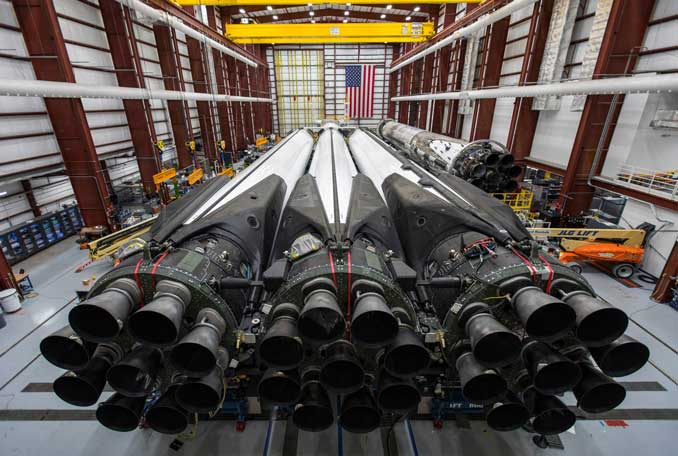
Using SpaceX’s new “Block 5” rocket stages, the second Falcon Heavy will generate up to 5.1 million pounds of thrust with its three boosters at full throttle. That’s nearly 10 percent more thrust than the first Falcon Heavy produced last year, using an older first stage design that is now retired, according to Musk.
The Falcon Heavy’s engines put out more thrust at liftoff than any rocket since the space shuttle.
Besides the increased thrust level, the Block 5 boosters have a beefed-up heat shield to better protect its engines and landing legs during re-entry back into the atmosphere. It also has sturdier titanium grid fins to replace aluminum steering winglets used on older Falcon boosters.
The first Block 5 first stage flew last May on a Falcon 9 launch with the Bangabandhu 1 communications satellite. Block 5 boosters have flown 13 times to date — all successfully — including on the March 2 launch of SpaceX’s first Crew Dragon test flight to the International Space Station.
The Block 5 booster will launch astronauts on the next Crew Dragon flight to the station later this year.
But the Falcon Heavy’s flight Thursday marks the first launch with three of the new boosters firing in unison.
“This is first launch of Falcon Heavy Block 5, so we’re being extra cautious,” Musk tweeted.
“First flight for Falcon Heavy Block 5 means there is some risk of failure between 5% to 10% imo (in my opinion),” he tweeted. “Many good design improvements from Falcon Heavy demo, but the changes are unproven.”
The three boosters will ignite in the final seconds of Thursday’s countdown, and hold-down clamps will release to free the Falcon Heavy to climb away from pad 39A.
The center core will throttle down its engines to conserve propellant during the first two-and-a-half minutes of the flight. The two side boosters will jettison at T+plus 2 minutes, 34 seconds, and flip around to fly tail first with the help of cold gas nitrogen thrusters.
The nine Merlin engines on Falcon Heavy’s core stage will throttle up to burn for another minute, while the side boosters will reignite three engines each to slow down their downrange velocity and begin accelerating back toward Cape Canaveral.
The core stage will switch off its engines at T+plus 3 minutes, 31 seconds, and target a touchdown on SpaceX’s drone ship “Of Course I Still Love You” in the Atlantic Ocean hundreds of miles east of Florida’s coastline.
A single Merlin upper stage engine will power up for the first of two burns required to inject the school bus-size Arabsat 6A spacecraft into a highly elliptical transfer orbit stretching nearly a quarter of the way to the moon.
After two more braking burns, the side boosters will touch down at Landing Zone 1 and Landing Zone 2 at approximately T+plus 7 minutes, 51 seconds. The core stage will encounter hotter temperatures than the side boosters as it heads toward landing at sea around T+plus 9 minutes, 48 seconds.
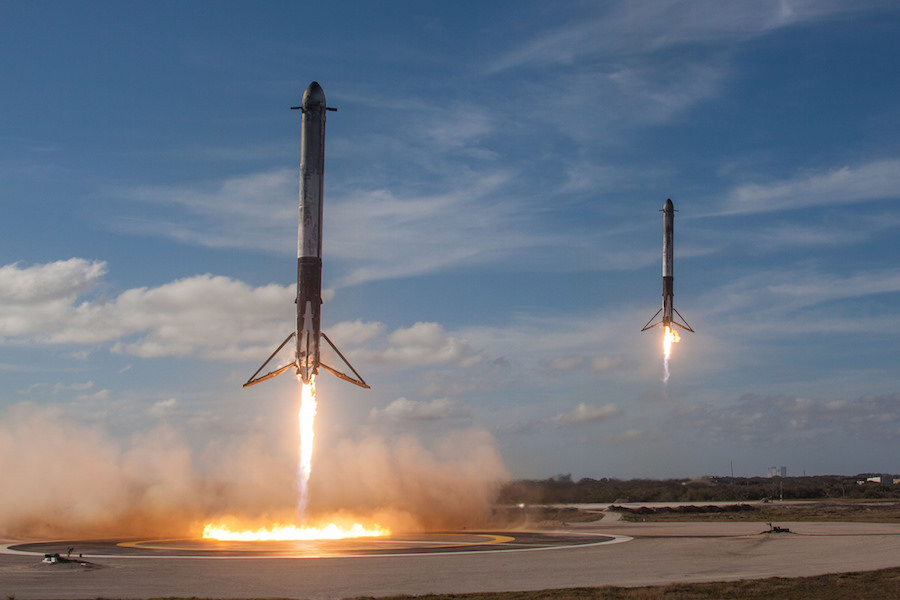
During last year’s Falcon Heavy test flight, the side boosters both returned safely to Cape Canaveral, but the core stage crashed in the Atlantic just off the deck of the drone ship after it ran out of igniter fluid.
Both side boosters recovered after last year’s Falcon Heavy test launch were retired from service. But this time, SpaceX is counting on a good recovery of the twin stages, which are fitted with aerodynamic nose cones, because they are slated to be reused on the next Falcon Heavy launch this summer.
The U.S. Air Force plans to launch a couple dozen small research satellites on the third Falcon Heavy flight. The mission, designated STP-2, or Space Test Program-2, will give the Air Force an opportunity to evaluate how SpaceX refurbishes its recovered rocket stages, helping the military move closer to certifying previously-flown hardware for future launches with critical and costly national security satellites.
Despite the adoption of SpaceX’s reused rockets by commercial satellite operators and NASA, the Air Force has not yet flown one of its missions with a Falcon rocket recovered from a previous mission.
Arabsat 6A heading for fuel-saving high-altitude orbit
While the dazzling display of three 15-story rockets returning to Earth will gain attention, the primary purpose of Thursday’s mission is to place the Arabsat 6A communications satellite into orbit.
The second stage’s Merlin engine will shut down at T+plus 8 minutes, 48 seconds, and head across the Atlantic Ocean before a restart over Africa at T+plus 27 minutes, 34 seconds.
The Falcon Heavy will aim for a “super-synchronous” transfer orbit ranging between 124 miles (200 kilometers) and nearly 56,000 miles (90,000 kilometers) above Earth, with an inclination of 23 degrees to the equator.
Deployment of the Arabsat 6A satellite is expected around 34 minutes after liftoff.
The spacecraft, built by Lockheed Martin, will soon contact ground controllers and unfurl its two solar array wings, which are based on a light-weight design that unrolls like a fabric, instead of the accordion-like design used by most satellites.
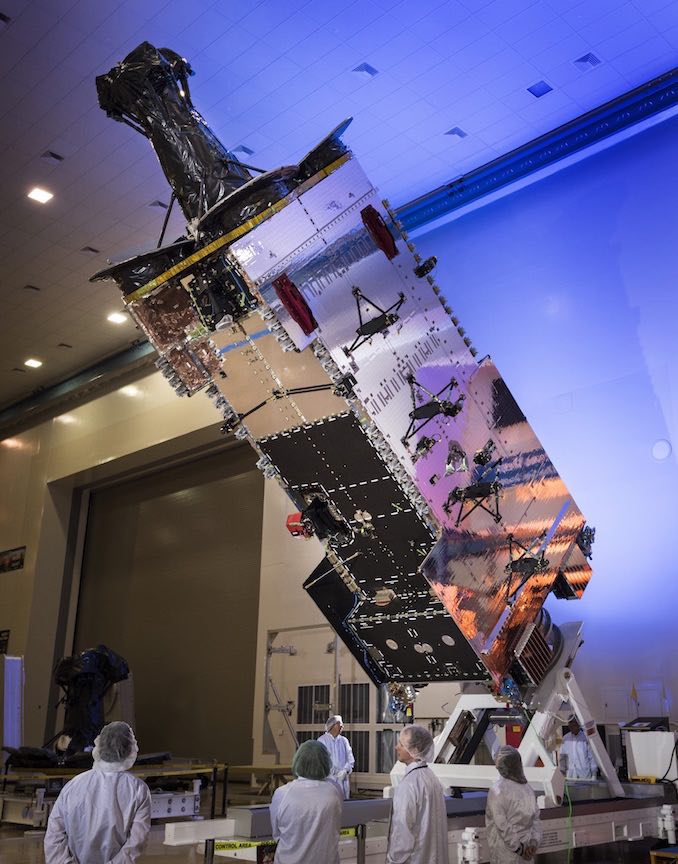
A Lockheed Martin spokesperson said the satellite weighs 14,252 pounds (6,465 kilograms) at launch, with its tanks fully loaded with hydrazine and nitrogen tetroxide maneuvering propellants.
Arabsat 6A will use its own thruster to guide the satellite into a circular geostationary orbit more than 22,000 miles (nearly 36,000 kilometers) over the equator, the perfect altitude to allow its velocity to match the rate of Earth’s rotation.
SpaceX’s Falcon 9 could have launched the Arabsat 6A satellite into a lower transfer orbit, but Arabsat booked a Falcon Heavy flight in 2015, before SpaceX introduced new Falcon 9 models that expanded its lift capability.
With the extra energy of the Falcon Heavy, the Arabsat 6A satellite will be deployed in a much higher orbit, reducing the time the spacecraft needs to consume to maneuver into its final operating position. Falcon 9 rockets launched a pair of Telstar communications satellites, both heavier than Arabsat 6A, last year, but those spacecraft were released into lower, less ideal “sub-synchronous” transfer orbits.
In a fully reusable configuration, assuming side booster landings at Cape Canaveral and a core stage recovery offshore, the Falcon Heavy can deliver around 17,600 pounds (8,000 kilograms) of payload to a standard geosynchronous transfer orbit, the typical drop-off point for communications satellites destined for posts at geostationary altitude.
If the Falcon Heavy did not have to set aside a fuel reserve to land its boosters back on Earth, the rocket could haul more than 15 metric tons — about 33,000 pounds — to geosynchronous transfer orbit, with an apogee near 22,000 miles.
The extra altitude boost provided by the Falcon Heavy will reduce the time Arabsat 6A needs to arrive in geostationary orbit to 17 days after launch, according to Guy Beutelschies, Lockheed Martin’s vice president of commercial satellite solutions. It also saves the satellite’s fuel to potentially allow for a longer operating life, adding years to the mission before Arabsat has to buy a replacement satellite.
After several weeks of payload checkouts and antenna deployments, Lockheed Martin will hand over control of the satellite to Arabsat by the end May to begin the spacecraft’s expected 15-year service life. Once on station, Arabsat 6A will use four gimbaled arcjet thrusters to maintain its orbit.
“Arabsat is a 21-member consortium of Arab states, and this satellite is going to be providing communications for the Middle East and North Africa,” Beutelschies said in an interview with Spaceflight Now before the launch. “So TV, radio, high-definition TV channels, and so forth.”
Arabsat 6A will be parked in geostationary orbit at 30.5 degrees east longitude to broadcast Ku-band and Ka-band signals. The new satellite will be co-located with Arabsat 5A at the 30.5 degrees east slot.
“This new satellite will strengthen our existing fleet that offers millions of people mobile and landline communications service across the region,” said Khalid Balkheyour, CEO of Arabsat, headquartered in Riyadh, Saudi Arabia, in a press release. “We look forward to completing and launching this state-of-the-art new satellite to offer even greater Internet, television and radio services to our customers.”
Arabsat 6A is the second of three commercial communications satellites built by Lockheed Martin to launch this year. The Hellas-Sat 4/SaudiGeoSat 1 telecom craft launched in February aboard an Ariane 5 rocket, and the Japanese-owned JCSAT 17 communications satellite is scheduled for launch on another Ariane 5 flight later this year.
They are the first commercial communications satellites built by Lockheed Martin to launch since 2012. The aerospace contractor invested in upgrading the company’s A2100 satellite line, which is commonly used by the U.S. military, to make it more attractive to commercial satellite companies.
“I think one of the most dramatic changes is we’ve got these new flexible solar arrays on-board that basically unfurl rather than having the old-style rigid panels,” Beutelschies said. “Because of that, they’re 30 percent lighter and 50 percent more power than our previous arrays. For Arabsat 6A, the one we’re about to launch, we actually have 20 kilowatts of solar array power for the vehicle.
“This goes all the way back to the solar arrays that we produced for the space station, where they actually unfurled,” he said. “You can pack it in a very small volume compared to the actual area once they’re unfurled.”
“You can kind of think of it as almost a fabric, and so it unfurls kind of like a window shade,” Beutelschies said. “It’s in a very small volume, and comes out and is pulled taut, and all the solar cells are mounted to it.”
Other changes to the commercial A2100 satellite design, known as the LM 2100, include new avionics and tunable antennas.
Email the author.
Follow Stephen Clark on Twitter: @StephenClark1.

